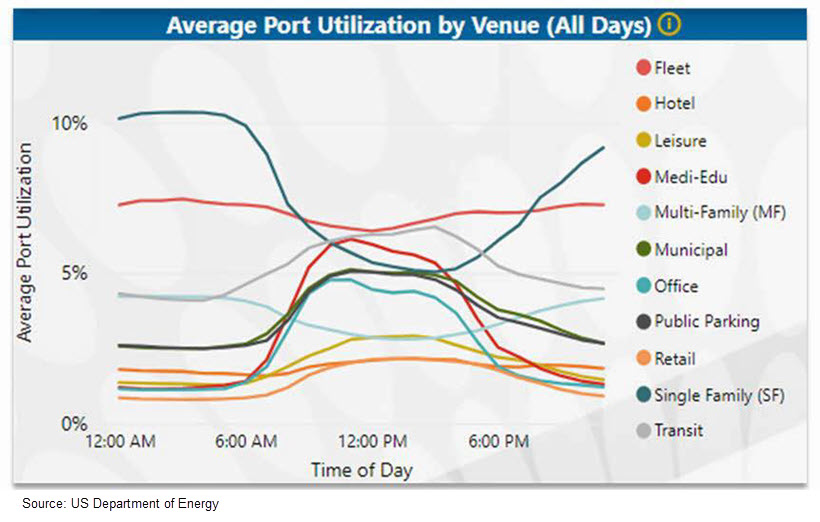Contents
What EVSE is and why it’s important
To enable transportation electrification, we need to increase the number of EV chargers, or electric vehicle supply equipment (EVSE). Today the US only has one charging station per 70 miles of road. In contrast, the Netherlands have about 20 stations per 70 miles. Fortunately, as part of the 2021 Bipartisan Infrastructure Bill, the US will deploy half a million EV charging stations across the country. That’s more than 10 times the number of public-access stations in operation in 2022. But we need to be strategic about how and where we install these EV chargers and keep in mind they’ll need regular maintenance.
Anyone deploying EVSE—including electric utilities, cities, states, vendors, and contractors—should build EV asset management plans. These plans should include how to size, site, install, maintain, and repair EVSE. And keeping the equipment cost-effective to operate and maintain for everyone is critical.
What EVSE is and why it’s important
EVSE is specialized, high-voltage equipment. It’s a single piece of equipment that includes all the software and hardware required to convert power from the electric grid into usable power to charge EV batteries (figure 1).
Figure 1: One charging station can have multiple ports and connectors
EVSE makes EV charging safer by adding a device between the electrical supply and the EV. This can help prevent battery overcharging, battery damage, and electrical fires. But this also creates another potential point of failure, which is why proper installation and maintenance are so important.
What types of EV chargers are there?
EV charging capabilities are characterized by voltage, current (alternating or direct), and time to recharge (speed of charge). To standardize EV charging, early EV engineers designated different levels of EV charging. Engineers then used these levels to develop electrical codes and standards to promote safe EV charging and EVSE installation.
Levels 1, 2, and 3 are low-, medium-, and high-voltage charging, respectively.
Level 1. This type of charger uses a standard, grounded three-prong plug to charge directly from a 120-volt outlet. Most passenger EVs come with a Level 1 charging cable that drivers can plug into any standard outlet to charge. This is the slowest option for charging an EV, adding just 2 to 5 miles of driving for every hour of charge time. We won’t spend much time addressing Level 1 charging in this paper because it doesn’t usually require asset management plans.
Level 2. Most EV charging equipment used by passenger EVs is Level 2. This is often a box that’s connected to 240-volt electrical service and plugs into the vehicle. Level 2 charging is typically 4 or 5 times faster than Level 1 charging and is usually about 99% efficient. Most of what the EV and energy industries have learned about EVSE asset management comes from experience with managing Level 2 networks.
Level 3. Level 3 includes a variety of EVSE with a supply voltage higher than 240 volts. The types of high-voltage EV charging are differentiated by whether they supply alternating or direct current (AC or DC) to the vehicle, as well as by how fast they can charge an EV. Level 3 fast chargers include DC fast chargers (DCFCs), AC fast chargers (ACFCs), legacy lower-power chargers, ultrafast chargers, and megawatt-scale chargers. DCFCs are the most common type of Level 3 chargers.
Which types of chargers will we need to meet the growth in demand?
There are about one-fifth as many charging stations as gasoline refueling stations in the US, and about one-half as many in Canada. According to the US Department of Energy’s Alternative Fuel Data Center’s Maps and Data, there were more than 30,000 public and private EV charging station locations in the US in 2020. These stations feature over 100,000 individual EVSE charge ports and serve about 75 EVs per station. Canada has 6,669 Level 2 and DCFC stations serving about 22 EVs per station, according to data on alternative fueling station tracking by Natural Resources Canada’s Electric Charging and Alternative Fuelling Stations Locator.
To reach the goals in the US infrastructure bill, we’ll need to add mostly Level 2 chargers (figure 2). This is because passenger vehicles are most commonly charged at home or work. Because people are usually in these locations for many hours at a time, they don’t need the speed of a Level 3 charger—a Level 2 or Level 1 charger will meet the need.
Figure 2: We need more Level 2 chargers
When deciding which level of charger to install, consider how long people are going to be at that location and how much power they’ll need. Some sites might require Level 3 because drivers aren’t there long enough to get an adequate charge from a Level 2 EVSE. And if people are at that location for fewer than a couple hours, it probably doesn’t make sense to install one at all. At those sites, a Level 3 charger may be more appropriate, but the decision-makers should still be careful about choosing the right site.
How to make EVSE more cost-effective to own and operate
Despite the need for more chargers, EV service providers (EVSPs)—the private companies who install, own, or operate chargers—may have trouble making a business case for deploying more EVSE. Someone needs to pay for the equipment, its installation and maintenance, and all the energy costs associated with EVSE operations, all while trying to compete with gas prices. Alternatively, rather than relying entirely on EVSPs to deploy and manage all EVSE, utilities and cities can include investments like this in the large balance sheets and manage the EVSE as part of other large collection of assets. To make these investments as cost-effective as possible for everyone, utilities and cities need to strategically site EVSE and offer the right incentives to the right customers.
Site EVSE in the right locations
Well-sited and properly installed equipment is easier to manage and tends to get damaged less often. Alternatively, immediate and widespread EV charger deployment will likely result in underutilized chargers and expensive maintenance issues. It also won’t have an effect on consumer EV purchasing decisions in the near term.
Recent research from the University of California Davis shows that deploying chargers ahead of the EV adoption curve may not lead to more EVs on the road. For more on this research, see the presentation by Kelly Hoogland at the 2021 STEPS+ Symposium More charging infrastructure may not mean more people see it (PDF).
To select EVSE sites strategically, work toward standardizing site selection, partner with communities, and use data on current EVSE usage.
Standardize site selection across all stakeholders. Private network operators, like EVSPs and EVSE network operators, have their own site selection processes. But without a federally standardized selection process, different organizations might install too many chargers in one location or not enough in another. A coordinated selection process could reduce the risk of over- and underutilized chargers from a mix of implementers.
Partner with communities. We also need to base these investment decisions on data and information about the lives and needs of individuals and communities. This is especially true when thinking about EVSE for underserved communities, including those who are disproportionately affected by environmental impacts and financial hardships.
We’ve seen an increase in the number of initiatives to add EV charging infrastructure for disadvantaged communities and low- and moderate-income customers. But to succeed, these initiatives need to be based on real data and carried out in partnership with these communities. If not, the initiative might waste time and resources.
Consult data on current usage. EVSE location can make a big difference in how many people use it. For example, the following graph shows average EVSE utilization rates throughout the day at different EV charging station venues (figure 3). Fleet vehicles have the highest utilization rates. Business fleet operations usually have a strong financial incentive to use their EV charging equipment because they want to get the most out of equipment they invested in. At the other end of the spectrum, hotel and retail locations have the lowest utilization rates.
Figure 3: Station location can significantly impact equipment utilization
Offer incentives for EVSE operation and maintenance
To increase adoption of EVSE, utilities should offer incentives that give funding for individuals, communities, and organizations to manage and maintain EV chargers after they’re installed. These operational incentives can also support trade ally certification and training and workplace charging development.
EV programs have grown in recent years, but utility and nonutility administrators are still offering only a handful of different program types (figure 4). And not enough of these programs reduce the cost of EVSE operation and maintenance.
Figure 4: Most EV incentive programs focus on reducing up-front costs for customers
Design unique EVSE programs for each application
EVSE applications tend to fall into one of three categories:
- Passenger vehicle charging. Most EVs on the roads are light-duty passenger vehicles. These vehicles use home charging, public charging, workplace charging, and corridor charging for light-duty vehicles.
- Fleet vehicle charging. While fleets may contain light-duty vehicles, many also include heavier vehicles. And charging demands at these sites tend to be greater. There are two main types of fleet charging: depot charging, such as at a commercial or industrial premise, and charging along highways and interstates.
- Off-road vehicle charging. Off-road EVs include forklifts, airport support vehicles, seaport support vehicles, mining and construction equipment, boats, airplanes, drones, etc. While off-road vehicle charging is a type of fleet charging, its needs are different from other fleet vehicle charging.
Traditionally, program administrators offer separate incentives for residential and business customers. But for EV charging, they should offer incentives to groups of customers based on the type of charging.
This might mean that administrators offer the same program across several customer types. For example, administrators can group together workplace charging and multifamily charging programs. These charging applications function in largely the same way even though the customer type is different.
Businesses will also have different EVSE needs for workplace and fleet charging. Administrators can coordinate EVSE installation for both applications, but they should offer separate programs, rates, and incentives.
How to install, maintain, and repair chargers
Utilities and administrators should invest in training a group of contractors and technicians (trade allies) who can install, repair, and maintain charging stations.
Train contractors in quality EVSE installation
Poor installation is the biggest contributing factor to equipment damage and operational issues. While some contractors have experience with EVSE, many haven’t received training or certification to install and commission EVSE. When installing new stations, carefully consider a contractor’s qualifications and require proper training and certification.
A few organizations offer EVSE training and certification services. The Electric Vehicle Infrastructure Training Program (EVITP) is a nonprofit, volunteer-driven industry collaborative. It’s made up of automotive manufacturers, electric utilities, EVSE manufacturers, educational institutions, and other EV stakeholders. EVITP offers a relatively low-cost training program ($275 per student) intended to teach existing certified electricians about EVs and their charging requirements.
Train EVSE maintenance crews
Like installation contractors, maintenance technicians also need specific EVSE training. Whether you find new EVSE technicians or work through your existing trade ally networks, you should give specific training to make sure the technicians are familiar with the EV charging equipment. Electrical contractors who don’t specialize in EVSE may treat EVSE repair calls as a lower priority than other field work. This will delay repairs and leave EV chargers off-line. And untrained technicians may not have the right testing equipment, tools, or replacement parts to safely and expediently diagnose and repair a problem in the field.
Partnering with businesses who provide EVSE repair training can reduce charger downtime to a few hours or days. One example of these organizations is ChargerHelp! The minority-owned business based in Los Angeles is dedicated entirely to EVSE repair and maintenance.
Train contractors and technicians to identify the source of EVSE failure
Station errors can lead to incomplete charging sessions and eventually the equipment stops working altogether. The best way to address these problems is to make sure the equipment is installed properly in the first place. But it’s also important that maintenance crews can identify which problem is causing the shutdown to make the right repair.
Poor installation is the most common underlying cause of EVSE degradation, equipment failure, and downtime. An improperly installed charging station can look like many things, including:
- The equipment is improperly mounted to a wall, pedestal, or concrete slab.
- The equipment isn’t protected from damages like vehicle collisions.
- The equipment isn’t properly weatherized or rated for outdoor use.
- The equipment is incorrectly or carelessly wired or grounded.
- The equipment uses an unsupported communications network.
- The equipment is installed in an unsafe or unmonitored location.
- The cables and dispensers are improperly sized or connected.
- The cables are bunched, bent, or sit or drag on the ground.
- There’s excessive solar exposure without shading.
Inspect equipment regularly
All stations in a network should be regularly inspected as part of preventive maintenance, even the stations that are rarely used. At a minimum, each piece of equipment should be thoroughly inspected and tested once a year. EVSE that customers use more regularly should be inspected at least twice annually.
Maintaining this equipment requires the right training and specialized tools. A proper maintenance routine should involve:
- Visually inspecting the equipment for damage
- Testing the user interface to make sure it works correctly
- Conducting an electrical test for safe and timely EV charging—make sure it supplies the power it’s rated to supply and that built-in safety mechanisms are functioning
Prepare electricians and technicians with information, tools, and equipment
In addition to the training we mention in the above sections, equip a well-prepared technician with the following.
Detailed information. Field crews often have limited or incorrect information when going into the field. This can be hard to avoid when diagnosing and repairing charging equipment that isn’t networked. Whoever manages the equipment should try to give technicians as much information as possible about the type of equipment on site; number and type of chargers, ports, and connectors; equipment age; installation type; and repair history. They should also give details about the equipment error, such as the error codes or reported issue. In some cases, errors with networked chargers can be remedied remotely without dispatching a field technician or crew.
Specialty tools. Electricians are used to using specialized tools for their trade, like insulated wrenches and meters for measuring voltage and current. For EVSE maintenance and repair, technicians will need less-common tools, such as meters that can simulate a charging fault and detect the response from the EVSE. These meters can cost thousands of dollars, and most electricians won’t already own them.
Specialty parts. An electrician can’t simply drive to the nearest hardware store or equipment distribution warehouse to get the parts they need to repair an EVSE. Nearly everything but the wiring on the EVSE is considered specialty equipment, including the cables and controllers. That means the technician needs to have common repair parts preordered and stocked on their van before going to an inspection or repair job.



